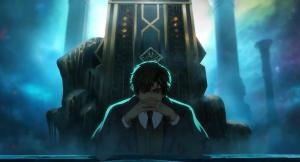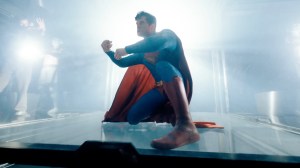Joe Hill’s novel NOS4A2 won fans over with its compelling blend of horror, fantasy, and drama, with the first season of its adaptation from showrunner Jami O’Brien debuting on AMC last year and delighting fans. Similar to the ways in which The Walking Dead adaptation found ways to honor its source material but also offer devout fans unexpected developments, NOS4A2 similarly brings iconic characters and sequences to life, all while keeping even the most passionate of fans on the edge of their seats. The second season of the series is currently airing on AMC on Sunday nights at 10 p.m. ET.
Videos by ComicBook.com
NOS4A2‘s second season picks up eight years after the events of season one. Vic McQueen (Ashleigh Cummings) remains more determined than ever to destroy Charlie Manx (Zachary Quinto). Charlie, having faced his own mortality, emerges desperate for revenge against Vic. This time, he sets his sights on the person who means most to Vic – her eight-year-old son Wayne. The race for Wayne’s soul sends Vic and Charlie on a high-speed collision course, forcing both to confront the mistakes of their pasts in order to secure a hold on Wayne’s future.
ComicBook.com recently caught up with O’Brien to talk about the process of adapting the series, its biggest challenges, and whether there are more adventures in store for the franchise.

ComicBook.com: Having grown up in Massachusetts, I was immediately impressed with how the series captured the unique look and feel of that part of the country. What do you feel it is about that geographic area that feels like a fantastical and creepy story like NOS4A2 could actually unfold there?
Jami O’Brien: Thank you for asking that question. It’s funny, I think about it a lot. First of all, I’ll say I grew up in Massachusetts as well. I’m from Billerica, Mass., which is kind of close to Haverhill [where the series takes place]. And so when I first read the novel and saw that it was his set in Haverhill, I couldn’t believe it. So I appreciate your appreciation of that part of the world. I’m glad to hear fellow Massholes feel we got it right, so thank you. And, I don’t know, does it go back to the Salem witch trials? I feel like there’s a lot of ghostlore in New England. I grew up with family stories of having seen ghosts.
My parents were divorced, my dad lived in a farmhouse for a while when I was a kid. My father, who I swear is an atheist and doesn’t believe in the supernatural, believes in ghosts. So I don’t know why that area … it feels like there’s a veil that’s thinner there, between the actual, real world, but it seems to be the case. Maybe it’s because there’s still woods. I don’t know.
Like in the story itself, it’s like New England is a “Shorter Way” to a more mystical realm.
I think there’s something to that. There are still old barns and old farmhouses and old covered bridges that ignite the imagination still. When you’re there, you feel a little like you’re walking among ghosts, I guess. It’s an inspiration, certainly to me, and I know that Joe Hill is from New England as well, he’s from Maine. So I guess it is to him, as well.
What makes the story so compelling is that we’re given the horror, sci-fi, and fantasy elements of the series, but it’s the drama that makes it all work. What did you find was the biggest challenge of bringing this story to life?
Well, to speak to what you’re talking about, the mashup, really, that is the show, that genre-bending that’s in the novel and also in our series, I remember early on some of our AMC executives, when I was pitching the show to them and said it’s a family drama and there are these supernatural elements, their concern was, when you go from scene to scene, how does it not feel like you’ve turned the channel from one show to another show? How does the show contain all these different elements and feel like one cohesive piece. And the answer, I think for us in the writers’ room, and then Kari Skogland, who directed the first couple episodes and really set the look for the show and the cinematic language for the show, she embraced this idea as well.
We tried, rather than trying to make the real world feel supernatural, we tried to ground the supernatural. So, for instance, Vic has a magical bridge that helps her find lost things. What we decided, and this, again, is taking our lead from the book, but what we decided in the writers’ room is that Vic can’t use her bridge just because she wants to go to the mall, for instance. Anytime that she’s going to open up that bridge, it has to be because she has a deep, emotional character need to do so. So we just tried to ground all of the supernatural in character moments and character needs. And then when Kari came along, I think to reinforce that with imagery, she was the one who said right from the beginning, “Great. I don’t want to ever see the bridge appear or disappear. Because when you see that, it starts to give you a ‘woo-woo’ feeling as opposed to ‘it’s there and then it’s not there.’ It makes it feel like, ‘Am I crazy? Was it just there?’ And also makes it a real thing.” We never see that bridge except as a solid real-world bridge. Does that make sense?
Yeah, if you mystically show it appearing, you have to visualize that and it breaks the reality. It’s also unnecessary how it appears, all that matters is it does appear and is real to the characters.
Right. And like Joe lays out and the novel, and again, we kind of embrace in the show, the bridge is both real and not real. It exists in Vic’s mind. It’s her Inscape. And with the help of her “knife,” she’s able to tear the fabric between the real world and the world of thoughts and pull her Inscape into the real world. And when she does that, it’s really there. It’s not invisible to other people, you know what I mean? It’s an actual, solid bridge that is sometimes in the real world, and then sometimes only in Vic’s mind.
As evidenced by the opening scene of the Season Two premiere, which starts with Charlie Manx’s “children” in Christmasland, it’s clear that you weren’t afraid to make changes to the source material, so how did you find the balance of feeling free to make changes while not getting too far off course?
In adapting the story, we came at it as lovers of the book. I don’t know how people are able to adapt a book that they don’t love. Everything began there and every deviation that we made from the book was really in trying to service the story in a new genre. The novel is fantastic and a lot of it is cinematic, but a lot of it is interior as well. For instance, at the end of Season One, when Vic is trapped in Charlie’s real-world house and he sets it on fire and she’s in the laundry chute. In the novel, Vic sets the house on fire and there’s a whole internal monologue about what her muddled thinking is because she’s acting on her feet and she’s not sure what to do.
She throws some dish towels in the oven and it’s described that she is thinking that she’s going to escape and the haze of smoke would cover her escape. I was protecting that moment because it’s a very iconic moment in the book and I loved it in the story. So I, in the writers’ room, was saying, “We have to do this. We have to make sure we do this. We have to make sure we do this.” And Tom Brady, who wrote the episode, said, “I have no idea how we’re going to convey that.” He said, “We can’t see into her head. There’s no one there for her to talk to.” He said, “It just is going to look crazy. Like she locked herself in and then set the house on fire.” I was like, “You’re right. You’re right.” And so that led to us keeping the sequence, but we had to change the intention. It made more sense on a television show for Manx to lock her in there and try to burn down the house rather than her locking herself in without the benefit of that internal monologue.
And since she’s alone, you don’t have to write a scene where she says out loud to no one, “My name is Vic McQueen and here’s why I’m setting the house on fire.”
Yes, exactly. Exactly.
Since AMC is known for expanding their popular series and there are currently 15 Walking Dead spinoffs–
There’s three.
Sorry, three spinoffs, since NOS4A2 and Vic’s journey will seemingly conclude with a third season, could you see the world of the show expanding with spinoffs?
I think that Joe created a really vast world in his novel. He hinted at a much bigger world than the world of Charlie and Vic. Though the novel is about Charlie and Vic, he hints that there are lots of other strong creatives and Inscapes in the world of the novel that extend beyond the novel. And so I really love working on the show. I really love the book. I love the whole idea of strong creatives and Inscapes. I think that there is absolutely a world in which that’s expanded. I think it depends on how successful our show is and what AMC’s appetite is for more NOS4A2, but I certainly would be up for it.
*****
New episodes of NOS4A2 air Sunday nights at 10 p.m. ET on AMC.
Header photo courtesy of Phillip Chin/WireImage/Getty Images









